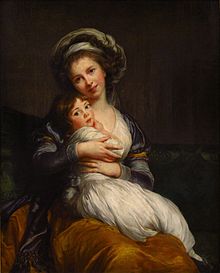- Louise Élisabeth Vigée Le Brun
-
Louise Élisabeth Vigée Le Brun 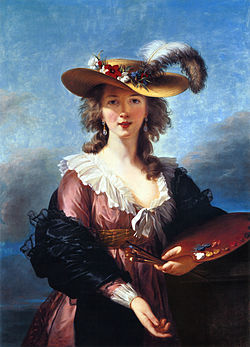
Self-portrait in a Straw Hat, 1782.Birth name Marie Élisabeth Louise Vigée Born 16 April 1755
Paris, FranceDied 30 March 1842 (aged 86)
Paris, FranceNationality  France
FranceField Painting Movement Rococo, Neoclassicism Louise Élisabeth Vigée Le Brun (Marie Élisabeth Louise; 16 April 1755 – 30 March 1842) was a French painter, and is recognized as the most famous female painter of the 18th century. Her style is generally considered Rococo and shows interest in the subject of neoclassical painting. Vigée Le Brun cannot be considered a pure Neoclassist, however, in that she creates mostly portraits in Neoclassical dress rather than the History painting. In her choice of color and style while serving as the portrait painter to Marie Antoinette, Vigée Le Brun is purely Rococo.
Contents
Marie Antoinette
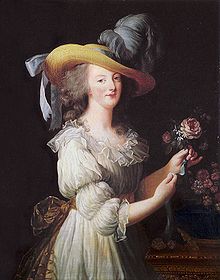 Portrait of Marie Antoinette, 1783. Attributed to Louise Élisabeth Vigée Le Brun.
Portrait of Marie Antoinette, 1783. Attributed to Louise Élisabeth Vigée Le Brun.
On 7 August 1775 she married Jean-Baptiste-Pierre Le Brun, a painter and art dealer. (Her husband's great uncle was Charles Le Brun, first Director of the French Academy under Louis XIV.) Vigée Le Brun painted portraits of many of the nobility of the day and as her career blossomed, she was invited to the Palace of Versailles to paint Marie Antoinette. So pleased was the queen that during a period of six years, Vigée Le Brun would paint more than thirty portraits of the queen and her family, leading to her being commonly viewed as the official portraitist of Marie Antoinette. Whilst of benefit during the reign of the Bourbon royals, this label was to prove problematic later.
On 12 February 1780, Vigée Le Brun gave birth to a daughter, Jeanne Julie Louise, whom she called "Julie".
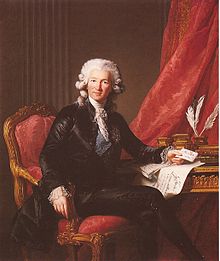 Charles Alexandre de Calonne, by Louise Élisabeth Vigée Le Brun
Charles Alexandre de Calonne, by Louise Élisabeth Vigée Le Brun
In 1781 she and her husband toured Flanders and the Netherlands where seeing the works of the Flemish masters inspired her to try new techniques. There, she painted portraits of some of the nobility, including the Prince of Nassau.
On 31 May 1783, Vigée Le Brun was accepted as a member of France's Académie Royale de Peinture et de Sculpture. She submitted numerous portraits along with an allegorical history painting which she considered her morceau de réception—La Paix qui ramène l'Abondance (Peace Bringing Back Prosperity). The Academy did not place her work within an academic category of type of painting—history or portraiture.
Adélaïde Labille-Guiard also was admitted on the same day. The admission of Vigée Le Brun was opposed on the grounds that her husband was an art dealer, but eventually they were overruled by an order from Louis XVI because Marie Antoinette put considerable pressure on her husband on behalf of her painter. The admission of more than one woman on the same day to the Académie encouraged comparisons among the works of the women instead of one woman contrasted with the existing members, who were men.
In 1789, she was succeeded as court painter to Marie Antoinette by Alexander Kucharsky.
French Revolution
After the arrest of the royal family during the French Revolution Vigée Le Brun fled France with her young daughter Julie. She lived and worked for some years in Italy, Austria, and Russia, where her experience in dealing with an aristocratic clientele was still useful. In Rome, her paintings met with great critical acclaim and she was elected to the Roman Accademia di San Luca.
In Russia, she was received by the nobility and painted numerous aristocrats including the last king of Poland Stanisław August Poniatowski and members of the family of Catherine the Great. Although the French aesthetic was widely admired in Russia there remained some cultural differences in what was deemed acceptable. Catherine was not initially happy with Vigée Le Brun's portrait of her granddaughters, Elena and Alaxandra Pavlovna, due to the area of bare skin the short sleeved gowns revealed. In order to please the Empress, Vigée Le Brun added sleeves giving the work its characteristic look. This tactic seemed effective in pleasing Catherine as she agreed to sit herself for Vigée Le Brun (although Catherine died of a stroke before this work was due to begin).[1]
 Alexandra and Elena Pavlovna, painted during Vigée Le Brun's time in St Petersburg.
Alexandra and Elena Pavlovna, painted during Vigée Le Brun's time in St Petersburg.
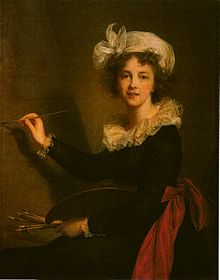 Self-portrait, painted at Florence, 1790
Self-portrait, painted at Florence, 1790
While in Saint Petersburg, Vigée Le Brun was made a member of the Academy of Fine Arts of Saint Petersburg. Much to Vigée Le Brun's dismay, her daughter Julie married a Russian nobleman.[2]
After a sustained campaign by her ex-husband and other family members to have her name removed from the list of counter-revolutionary émigrés, Vigée Le Brun was finally able to return to France during the reign of Emperor Napoleon I. In spite of being no longer labeled as émigrée, her relationship with the new regime was never totally harmonious, as might be expected given that she was a strong royalist and the former portraitist of Marie Antoinette.
Much in demand by the élite of Europe, she visited England at the beginning of the 19th century and painted the portrait of several British notables including Lord Byron. In 1807 she traveled to Switzerland and was made an honorary member of the Société pour l'Avancement des Beaux-Arts of Geneva.
She published her memoirs in 1835 and 1837, which provide an interesting view of the training of artists at the end of the period dominated by royal academies. Her portrait of fellow neoclassical painter, Hubert Robert, is in Paris at Musée National du Louvre.
Still very active with her painting in her fifties, she purchased a house in Louveciennes, Île-de-France, and lived there until the house was seized by the Prussian Army during the war in 1814. She stayed in Paris until her death on 30 March 1842 when her body was taken back to Louveciennes and buried in the Cimetière de Louveciennes near her old home.
Her tombstone epitaph states "Ici, enfin, je repose…" (Here, at last, I rest…).
Vigée Le Brun left a legacy of 660 portraits and 200 landscapes. In addition to private collections, her works may be found at major museums, such as Hermitage Museum, London's National Gallery, in Europe and the United States.
Portrayal in popular culture
- In 2006, Le Brun was portrayed in an uncredited scene during the film Marie Antoinette.
See also
References
 This article incorporates text from a publication now in the public domain: Chisholm, Hugh, ed (1911). Encyclopædia Britannica (11th ed.). Cambridge University Press.
This article incorporates text from a publication now in the public domain: Chisholm, Hugh, ed (1911). Encyclopædia Britannica (11th ed.). Cambridge University Press.- Lebrun, Souvenirs, Paris, 1835–1837 (translated by Lionel Strachey, New York, 1903).
- Italian Wikipedia
- CyberPathways Art World
External links
- Large gallery of Vigée LeBrun's work; also articles, Memoirs, biographies
- Artcyclopedia entry on Louise Elisabeth Vigée Le brun
- Vigée-Lebrun's Portrait of Carlo Gastone della Torre di Rezzonico at artnet
- Old Masters: Overlooked Women Artists
- Memoirs of Madame Vigée Le brun, translated by Lionel Strachey
- Neil Jeffares, Dictionary of pastellists before 1800, online edition
Further reading
- The Memoirs of Elisabeth Vigée Le Brun Camden Press 1989 (Unabridged translation by Siân Evans)
- Angelica Goodden, The Sweetness of Life: A Biography of Elisabeth Louise Vigée Le Brun, Andre Deutsch Limited, London, 1997
- Gita May, Elisabeth Vigée Le Brun: The Odyssey of an Artist in an Age of Revolution, Yale University Press, New Haven, 2005 ISBN 0-300-10872-9
Categories:- 1755 births
- 1842 deaths
- Artists from Paris
- French painters
- Portrait artists
- French women artists
- French memoirists
- French women writers
- Women painters
Wikimedia Foundation. 2010.

